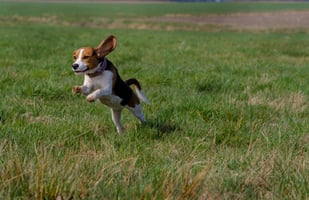Teaching your dog to heel is an important part of any obedience training program. Heeling is a...
How to Teach Your Dog Not to Bite
Teaching your dog not to bite is an important part of responsible pet ownership. There are several techniques that you can use to help your dog learn this important lesson. It is important to be consistent and patient while training your pup, as it may take some time before they understand the concept. Additionally, it is important to understand why your dog may be biting in the first place, so you can address the problem and prevent it from happening again.
Identifying the Cause of Biting
Before you can begin to teach your pup not to bite, it is important to identify the root cause of the biting behaviour. This can be difficult to do, as it may not always be obvious. Some common causes of biting include fear, anxiety, boredom, teething, or aggression.
Fear: If your pup is biting out of fear, it is important to understand what is causing them to feel scared. It could be a loud noise, a person, or another animal. Once you identify the source of their fear, you can take steps to help them feel more comfortable.
Anxiety: Dogs may bite out of anxiety. This can be caused by a change in the environment, such as a new person or pet in the house, or a change in routine. If your pup is feeling anxious, it is important to provide them with a safe and comfortable environment.
Boredom: Boredom can also cause your pup to bite. If your pup is not getting enough exercise or mental stimulation, they may start to act out. Providing your pup with plenty of toys and activities can help to keep them happy and occupied.
Teething: Puppies may bite out of teething. This is a normal behaviour and should not be punished. Providing your pup with plenty of chew toys can help to alleviate their discomfort.
Aggression: Aggression can be caused by a variety of factors, including fear, anxiety, and dominance. If you suspect that your pup is displaying aggressive behaviour, it is important to seek the help of a professional trainer or behaviourist.
Using Positive Reinforcement
Once you have identified the cause of the biting behaviour, you can begin to address it. It is important to remember that punishment is not the answer. Instead, you should focus on using positive reinforcement to teach your pup the desired behaviour.
Positive reinforcement is a powerful tool for teaching dogs. It involves rewarding your pup for displaying the desired behaviour. This can be done with treats, toys, and praise. When your pup displays the desired behaviour, give them a reward. This will help to reinforce the behaviour and encourage them to do it more often.
It is important to be consistent and patient when using positive reinforcement. It may take some time before your pup understands what behaviour is desired, so it is important to be patient and consistent with your training.
Using Redirection
In addition to positive reinforcement, you can also use redirection to teach your pup not to bite. Redirection involves distracting your pup from the undesired behaviour and encouraging them to focus on something else. For example, if your pup is biting, you can distract them with a toy or treat. This will help to redirect their attention away from the undesired behaviour.
It is important to remember that redirection should not be used as a punishment. Instead, it should be used as a way to help your pup focus on something else. Additionally, it is important to be consistent and patient when using redirection.
Using Training Aids
There are also several training aids that can be used to help teach your pup not to bite. These include bite inhibitors, muzzles, and head halters. Bite inhibitors are collars that emit a loud noise or vibration when your pup bites. This can help to startle them and deter them from biting.
Muzzles can also be used to help prevent your pup from biting. However, it is important to remember that muzzles should not be used as a punishment. They should be used as a way to prevent your pup from biting while still allowing them to interact with people and other animals.
Head halters are another tool that can be used to help prevent your pup from biting. They work by gently redirecting your pup’s attention away from the undesired behaviour. They can be a great tool for teaching your pup not to bite.
Conclusion
Teaching your pup not to bite is an important part of responsible pet ownership. There are several techniques that you can use to help your pup learn this important lesson. It is important to be consistent and patient while training your pup, as it may take some time before they understand the concept. Additionally, it is important to understand why your pup may be biting in the first place, so you can address the problem and prevent it from happening again.
Using positive reinforcement, redirection, and training aids can all help to teach your pup not to bite. It is important to remember to be consistent and patient when training your pup. Additionally, it is important to understand why your pup may be biting in the first place, so you can address the problem and prevent it from happening again.
With patience and consistency, you can teach your pup not to bite. It is important to remember that punishment is not the answer. Instead, focus on using positive reinforcement and other training techniques to help your pup learn the desired behaviour.



